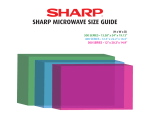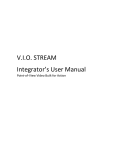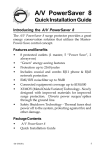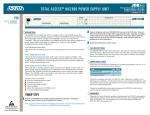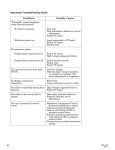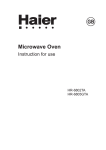Download service manual.cdr
Transcript
CONTENT Chapter 1 Microwave Oven Composition and Operating Principle 1. Microwave Oven Composition 2. Microwave Oven Operating Principle 3. Microwave Oven Circuit Principle Chapter 2 Microwave Oven Common Faults and Maintenance 1. Attention Points on Maintenance 2. Microwave Oven Parts Assembling and Disassembling Process 3. Microwave Oven Test and Trial Run after Repairing 4. Microwave Oven Common Faults and Diagnosis to Them Appendix 1 Microwave Oven Dismounting Exploded View Appendix 2 Microwave Oven Specifications -1- Chapter 1 Microwave Oven Composition and Operating Principle 1. Microwave Oven Composition (1) Fire Door Safe Lock System (5) Glass Turntable (2) Observation Window (6) Control Panel (3) Spiracle (7) Rollaway Nest (4) Swivel 5 4 6 3 7 1 1 2 Microwave Oven is mainly composed of heating room, microwave source and control panel. Heating room is composed of cavity combination, turntable system and fire door. Microwave source is mainly composed of magnetron, transformer, high-voltage capacitor and high-voltage diode. Control panel consists of timer, power selector, and so on (Computer-type control panel mainly consists of computer board). -2- 2. Microwave Oven operating principle Microwave oven operating principle block-diagram is as follows: WAVEGUIDE MAGNETRON HEATING ROOM CONTROL SYSTEM MULTIVOLTAGE RECTIFICATION CIRCUIT POWER Microwave Oven supplies magnetron constant and reliable operating voltage and operating time through control system and multivoltage rectification circuit after power is on, Control system also acts as safety monitor of magnetron. The controlled microwave produced by magnetron is transmitted into microwave heating room through wave-guide, part of which directly enters inside food after entering heating room, the rest enters food after repeated reflection by cavity wall, it is absorbed to produce heat for completing all operations such as heating, cooking and sterilization. 3. Microwave Oven Circuit principle NOISEFILTER T1 SW1 L SWA FA L F1 8A F3 2A 130 SWC C2 M SW2 F S11 C1 C L R1 T MF F2 0.8A MT R2 N D AW U 8.0 C3 L SWB SO N FU2 100 FU2 105 SW1: Timer Time Control Switch L: Lamp T: Timer Motor SW2: Timer Fire Control Switch SWA: Door 1 Safe Switch MF: Fan Motor SWB: Door 3 Safe Switch MT: Turntable Motor SWC: Door 3 Safety Monitoring Switch -3- Chapter 2 Microwave Oven Common Faults and Maintenance 1. Attention points on maintenance 1. When microwave oven needs checking or dismounting, you should pull out the plug to shut off the power, letting microwave wipe stop working. To guarantee personal safety, never operate it with power on. 2. Never open the housing to check or repair high-voltage transformer, high-voltage winding and magnetron filament winding while the unit is on, if test or replacement is in need, you should first draw off power plug, discharge high-voltage capacitor, to avoid high-voltage electric shock and microwave radiation. 3. When you are checking the unit, please never insert some metal such as screw or conductor into cracks of the fire door, never keep impurity such as tools in the oven to avoid short-circuit spark or electric shock, which is caused by their reaching charged parts of the unit, at the same time, effective radioactive antenna can not coming into being to cause excessive microwave leakage. 4. When you disassemble turntable motor or replace transformer, never make door surface against the earth to place it to avoid being damaged or deforming. You should place it on rubber cushion without impurity, its flank inclined. 5. You should fix the screw firmly while repairing. Do avoid inclination and slippage, otherwise you should reassemble it or replace screw, or take other measures. 6. Be sure interconnecting devices are connected properly and firmly when you replace capacitor components. If any is loose, please clamp the plug firmly with sharp-nose pliers and plug it to the right place. 7. When you have repaired it , please fill in guarantee card in detail as form. -4- 2. Microwave Oven Parts Assembling and Disassembling Process 1. Assembling and Disassembling of housing (1) Unscrew fixed screw of housing (2) Push the housing backward to detach it. (3) Installation is reverse to above illustration, make housing turnup edge slip forward along cavity combination, pay attention to fit both sides of housing, up turnup edge to cavity combination. 2. Assembling and Disassembling of Timer (1) Detach the housing and pull out timer knob. (2) Pull out connector plug of timer. (3) Unscrew screws fixing control panel and detach the control panel. (4) Installation is reverse to above illustration, pay attention not to make principal axis and knob of rub against control panel. (5) Check timer assembling after installation: Turn timer clockwise to some-angle and return to 0 position, you may hear ring bell, if there is deviation, please readjust the screw to ensure concentricity of timer principal axis and panel hole. 3. Assembling and Disassembling of Safe Switch Board. (1) Detach the housing, pull micro-switch wire plug out of switch board. (2) Unscrew 2 screws fixing switch board and detach switch board. (3) Pull micro-switch out of switch board. (4) Installation is reverse to above illustration, pay attention to check whether micro-switch is installed to proper position. The position should be right, wiring plug should be firmly fixed, the fire door can be opened or closed flexibly, otherwise you should readjust 2 screws fixing switch board. 4. Assembling and Disassembling of Motor (1) Take out glass turntable, swivel, coupler, and so on. (2) Turn microwave oven upside down, detach middle cover with pliers and screwdriver. (3) Unscrew 2 screws fixing turntable motor, pull out wiring plug, take out the motor. (4) Installation is reverse to above illustration. 5. Assembling and Disassembling of Transformer (1) Detach the housing. (2) Pull out wiring plug of primary, secondary and high voltage filament of transformer. (3) Turn microwave oven upside down. (4) Unscrew 4 screws fixed in baseboard and take it together with transformer. (5) Installation is reverse to above illustration. -5- 6. Assembling and Disassembling of Magnetron (1) Detach the housing. (2) Pull out wiring plug of magnetron and temperature regulator. (3) Unscrew screws fixing air-intake hood. (4) Unscrew screws fixing magnetron. (5) Installation is reverse to above illustration. 7. Assembling and Disassembling of Fire Door (1) Detach the housing. (2) Unscrew hinge screws in fire door. (3) Raise the fire door a little to detach it. (4) Attention points on assembling fire door. a. Smear a little silicone grease on rotating part of the door. b. Fire door should fit switch board well in door installation, to be sure it can be opened or closed flexibly, and door safe switch work well. c. Cracks of fire door should be as wide as possible, The door should rotate fl exibly, Inclination or stagnation is forbidden. (5) Installation Is reverse to above illustration. The unit should be tested with microwave leakage meter after installation, so as to avoid excessive microwave leakage. 3. Microwave Oven Test and Trial Run after Repairing (1) Safe grounding, microwave oven needs good grounding to avoid clectric shock and disturbance. (2) Parts should be fixed firmly, electric components should be connected properly, each plug and connecting device should be connected firmly, looseness is forbidden. (3) Never keep impurity in the oven (4) Never test microwave oven without any loading, you should put food such as a cup of tea in it, to prevent magnetron from burning on condition that microwave can be absorbed nowhere. (5) Never detach the housing to test the unit. (6) Insulation property: Use 500 volte megohm meter to check whether insulation resistance between power plug and uncharged metal part of housing is over 20 megohm. (7) After overall unit is heavy repaired (such as replacing cavity combination). Fire door should be measured with microwave power leakage meter, in any place 5-centimeter far from microwave oven, microwave leakage power density should not exceed 1 mw/cm2 (8) Following safety check is necessary before power is on. I. Check whether fire door can be opened and closed well. II. Check whether fire door and seal surface, plug and bolt are damaged or loosen. III. Check whether safety device can work well. -6- 4. Microwave Oven Common Faults and Diagnosis to Them Fault appearance Cause Diagnosis 1. Three no happens to microwave oven when it is turned on. 1. Fuse wire is broken. 2. Capacity transformer primary or secondary short circuit 3. Capacitor-to-earth disruption or polar-to-polar disruption. 4. Monitor switch can not be turned off. 5. Interlock switch is on 6. Loose contact between power plug and outlet. 7. Gate stop is broken. 1. 2. 3. 4. 5. 6. Replace the fuse wire. Replace power transformer. Replace capacitor. Replace monitor switch. Replace interlock switch. Adjust the connection or replace it. 7. Replace gate stop. 2. Microwave oven is on, lamp is on, turntable and fan works, but food in it can not be heated. 1. Power transformer primary or secondary disconnection, filament is disconnected. 2. Magnetron filament disconnected, magnetron magnetic steel cracking or magnetron air leakage. 3. Power timer can not work. 4. Plug of magnetron or capacitor is loose. 1. Replace power transformer. 2. Replace magnetron. 3. Replace power device, timer or micro-switch. 4. Replace it. 3. Microwave oven can heat, but the oven lamp is off. 1. The oven lamp can not work. 2. Plug is loose. 1. Replace the lamp. 2. plug the plug. 4. Microwave oven can heat, bu turntable can not work. 1. Something is wrong with the motor. 2. Plug is loose. 3. Connecting axle sleeve cracking. 1. Replace turntable motor. 2. Plug the plug. 3. Replace connecting axle sleeve. 4. Microwave oven can heat, within 2 to 3 minutes, can not heat if time exceeds 4 minutes. 1. Fan motor winding disconnected. 2. Fan, motor blade is loose. 3. Fan motor plug is loose. 4. Motor rotation axle and bearing grip each other. 5. Cooling air passage blocked. 1. 2. 3. 4. 5. 6. Microwave oven is on, it hums but can not heat. 1. High-voltage diode disruption. 1. Replace the high-voltage diode. 7. Microwave oven can heat but neighs loudly. 1. Power transformer core is loose. 1. Replace the Power transformer. 8. Microwave oven microwave leakage is serious. 1. 2. 3. 4. 5. 1. Overhaul and reshape it. 2. Replace the door. 3. Adjust the space between cracks of the door. 4. Replace the cavity body. 5. Screw the fixing screw. 6. Scrape oxide layer and screw the screw. Door is deformed. Door metal loop cracking. Crack of the door is wide. Cavity soldered dot is loose. Magnetron fixing screw is loose. 6. Wave-guide connection oxidation. -7- Replace the fan motor. Replace the fan blades. Plug the plug. Overhaul it. Check it. 7. Magnetron copper wire cushion ring is thin and waveguide connector contacts ground loosely. 7. Thicken the copper cushion ring. 9. Microwave oven door can not be opened. 1. Space between door axle and axle hole becomes wider and door inclined one way because of long-term damage and corrosion. 3. Gate stop is broken. 1. Adjust door hinge to rectify the door. 2. Replace the gate stop. 10. Button is loose It becomes damaged or aging because of long-term operation. Overhaul or replace it. 11. Microwave oven electric leakage. Insulation resistance of every motor, transformer and ground is less than 2 megohm. Check electric leakage place with megameter, repair or replace damaged components. PRECAUTIONS TO BE OBSERVED BEFORE AND DURING SERVICING TO AVOID POSSIBLE EXPOSURE TO EXCESSIVE MICROWAVE ENERGY (a) Do not operate or allow the oven to be (c) Before turning on microwave power for any service test or inspection within the microwave operated with the door open. generating compartments, check the magnetron, wave guide or transmission line (b) Make the following safety checks on all ovens and cavity for proper alignment, integrity, and to be serviced before activating the magnetron connections. (d) Any defective or misadjusted components in or other microwave source, and make repairs the interlock, monitor, door seal, and as necessary. microwave generation and transmission systems shall be repaired, replaced, or (1) Interlock operation adjusted by procedures described in this (2) Proper door closing manual before the oven is released to the owner. (3) Seal and sealing surfaces (arcing, wear and (c) A Microwave leakage check to verify other damage) compliance with the Federal performance (4) Damage to or loosening of hinges and latches standard should be performed on each oven (5) Evidence of dropping or abuse. prior to release to the owner. -8-









